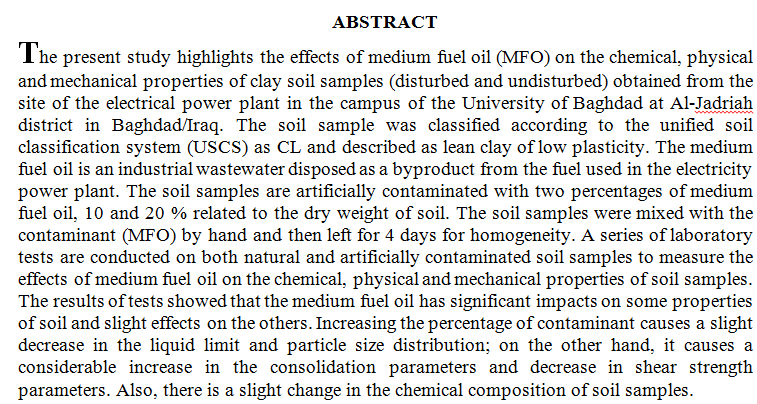
Organic soil is problematic soils in geotechnical engineering due to its properties, as it is characterized by high compressibility and low bearing capacity. Therefore, several geotechnical techniques tried to stabilize and improve this soil type. In this study, sodium silicate was used to stabilize sand dune columns. The best sodium silicate concentration (9%) was used, and the stabilized sand dune columns were cured for seven days. The results for this soil were extracted using a numerical analysis program (Plaxis 3D, 2020).In the case of studying the effect of (L/D) (where ‘’L” and ‘’D’’ length and diameter of sand dune columns) of a single column of sand dunes stabilized with sodium silicate with a diff
... Show More (3)
(3)
Smart water flooding (low salinity water flooding) was mainly invested in a sandstone reservoir. The main reasons for using low salinity water flooding are; to improve oil recovery and to give a support for the reservoir pressure.
In this study, two core plugs of sandstone were used with different permeability from south of Iraq to explain the effect of water injection with different ions concentration on the oil recovery. Water types that have been used are formation water, seawater, modified low salinity water, and deionized water.
The effects of water salinity, the flow rate of water injected, and the permeability of core plugs have been studied in order to summarize the best conditions of low salinity
... Show More (2)
(2)
Iron , Cobalt , and Nickel powders with different particle sizes were subjected to sieving and He-Ne laser system to determine the particle size . 1wt% from each powders was blended carefully with 99wt% from Iraqi oil . Microscopic examination were carried for all samples to reveal the particle size distribution . A Siemens type SRS sequential wavelength dispersive(WDS) X-ray spectrometer was used to analyze all samples , and the XRF intensity were determined experimentally and theoretically for all suspended samples , Good agreement between theoretical and experimental results were found .
The current study was conducted for studying the impact of cold plasma on the expression level of three genes that participate in the biosynthesis of the phenylpropanoid pathway in Ocimum basilicum. These studied genes were cinnamate 4-hydroxylase (c4h), 4-coumarate CoA ligase (4cl), and eugenol O-methyl transferase (eomt). Also, the cold plasma impact was studied on the essential oil components and their relation with the gene expression level. The results demonstrated that cold plasma seeds germination of the treated groups 2 (initially for 3 minutes and 3 minutes after 7 days) ,and group 3(initially for 5 minutes and 3 minutes after 7 days) were faster than the control group. Also, the height average of the mature plants of
... Show More (4)
(4)
 (1)
(1)
The electrical properties of the AlNiCo thin films with thickness (1000oA) deposited on glass substrates using Ion – Beam sputtering (IBS) technique under vacuum <10-6 torr have been studied . Also it studied the effect of annealing temperature from this films , It is found that the effective energy decrease with increase of temperature and the conductivity decrease with increase temperature 323oK but after this degree the conductivity increasing .
Assume that G ≅ HN the Harada–Norton group. In this paper, effective investment for the graph ΓRI HN standard features to acquire meaningful algebraic results for the graph ΓRI HN and its corresponding group HN. For instance, marketing a modern methods to understand the way of create a precise small subgroups in G. Furthermore, performing a full investigation for getting particular ΓRI HN parameters.
Background: The quality of drinking water is directly related to community health. Therefore, improving the quality of drinking reflects positively on the health situation in general. The studies that deal with the quality of drinking water in the city of Baghdad in terms of chemical or microbial content are very scanty. Objective: The current review highlights the most important studies and research articles that concern the quality of drinking water, both bottled water and tap water, in terms of chemical and biological contamination and chemophysical specifications for drinking water. Abstract: Studies have shown that drinking water in the city of Baghdad, especially tap water, contains certain levels of heavy metals,
... Show More (3)
(3)
 (1)
(1)
The optical transmission and absorption spectra in UV-VIS were recorded in the wavelength range 350-800 nm for different glass compositions in the system: (CuO)x (PbO)50-x (Bi2O3)50 (x=2.5, 5.0, 7.5, 10.0, 12.5, 15.0, 20.0). Absorption coefficient {α (λ)}, optical energy gap (Eopt), refractive index (n), optical dielectric constant (ε`), Urbach energy (Ee), constant B and ratio of carrier concentration to the effective mass (N/m) have been reported. The effects of compositions of glasses on these parameters have been discussed. It has been indicated that a small compositional modification of the glasses lead to an important change in all the optical properties including non-linear behavior. The optical parameters were found to b
... Show More